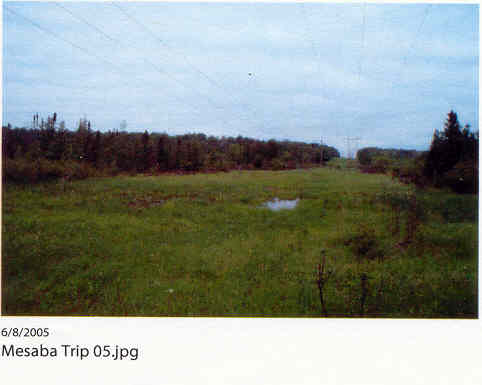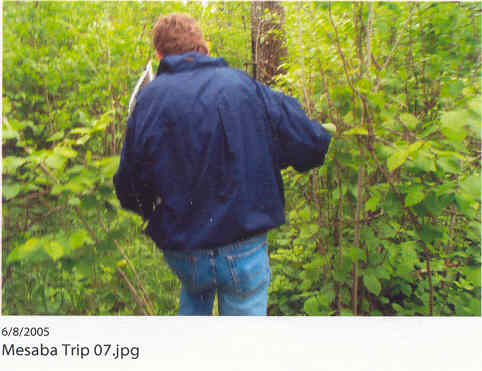Big Stone brouhaha in ND
September 3rd, 2006

The other day there was a “heads up” in the inbasket that the editorial page of the Fargo Forum had lit up about Big Stone II, and then another! In the Bismarck Tribune too! Seems the “Joint Intervenors” from Big Stone, Goodpaster of MCEA (Outrage Expressed...), Grant of Waltons, Noble of ME3, and also Zellar of Clean Water Action Alliance, had joined in a Letter to the Editor sent to both papers. That’s weird, because BSII is in SOUTH Dakota, so why? But maybe it’s a slow day in ND? (There was also a transmission editorial in Bismarck, which I’ll get to later) If you do a search of the Fargo paper, what you get is a screen to buy the article! Anyway, here’s the first letter, from the “Joint Intervenors,” and then the “Big Stone Partners” response follows, from the Fargo Forum:
Big Stone II wrong project, wrong time, old technology
08/25/2006 – By Beth Goodpaster, Bill Grant, Michael Noble and Marie Zellar
The commentary from seven utility company leaders lauding the proposed Big Stone II project smacks of desperation on the part of highly paid executives who fear their plan to continue using old-fashioned technology might be in danger. (Forum, Aug. 6)
And it is.
Letâ??s review for a minute. The testimony we brought forth during the South Dakota hearings established that global warming will continue to cause significant harm to the world and the region. Carbon dioxide is the main global warming pollutant, and Big Stone II will emit enormous amounts of it.
How much? Try 4.5 million tons every year, or substantially more carbon dioxide than is produced by all the cars in South Dakota.
But we didnâ??t just say, â??Donâ??t build Big Stone II,â? and then sit down. We showed that a portfolio of responsible alternatives emphasizing energy-efficiency and wind energy is cleaner and more costefficient. The testimony showed wind energy investment would create seven times as many jobs and add five times more money to South Dakotaâ??s economy. With developed wind resources, southwestern Minnesota farmers are poised to be big players in this alternative.
Our plan produces little or no global warming pollutants and none of the mercury and other emissions the Big Stone II gang is struggling to reduce from its smokestacks.
As for their talk of a â??looming energy crisis,â? there isnâ??t one. The last time we heard talk like that, it was by Enron folks mocking California for its rolling blackouts. Only later did we learn Enron caused the â??crisisâ? by manipulating the energy markets. There is plenty of electrical energy for these utilitiesâ?? customers and we have suggested a plan that would provide plenty more.
These utility executives want you to believe that at no time in the next 30 years will Congress slap costly carbon controls on Big Stone II. However, these are the same people who two years ago couldnâ??t even foresee the cost of their own proposed power plant jumping 50 percent to its current $1.8 billion. If they are wrong again and Congress does what seems very likely, all of us, the utility customers, will be paying for it through higher electric rates.
We all have a right to expect our utilities to invest in modern and innovative energy technologies that are efficient, clean and reliable. The Big Stone II executives have offered an antiquated solution that is irresponsible and far too costly.
We can do better and look to the Minnesota Public Utilities Commission to provide the leadership.
Goodpaster is attorney for Minnesota Center for Environmental Advocacy.
Grant is associate executive director of the Midwest office of the Izaak Walton League.
Noble is executive director of Fresh Energy.
Zellar is Midwest regional director for Clean Water Action.
All are of Minnesota.
=======================================
Here’s the response from Montana-Dakota Utilities, I’d guess on behalf of all the Big Stone partners. It showed up on the SEED list thanks to Elizabeth Dickenson — I sure wouldn’t expect a BSII editorial in North Dakota!
Critic of Big Stone II project did not tell the whole story
By Bruce Imsdahl,
Published Friday, September 01, 2006 â?? Fargo ForumIn response to Beth Goodpasterâ??s commentary, which was published in the Forumâ??s August 25, edition â?? â??Big Stone II wrong project, wrong time, old technologyâ?:
Goodpaster left Forum readers with the impression that the Big Stone II participants have been irresponsible in planning to construct a 600-megawatt, coal-fueled power plant in northeastern South Dakota. Her contentions need clarification.
For the past several years, seven regional energy suppliers have been analyzing the feasibility of building a large, baseload generating facility. We found the site of the current 440-megawatt Big Stone I plant to be the most feasible from the standpoint of transmission access, rail service, water availability and other considerations. Earlier this summer, following a week of public hearings, the South Dakota Public Utilities Commission approved the plant siting permit. The water appropriation and waste disposal permits have also been approved by other South Dakota state agencies.
Big Stone II will be a baseload facility, which means, aside from repairs and scheduled maintenance, it will operate around the clock to supply our customersâ?? electricity needs. Electricity suppliers have four baseload options: natural gas, nuclear, coal or hydro. For cost and permitting reasons, coal is our best generation option.
In contrast, Goodpaster asserts that wind energy would be a better baseload alternative. This is simply not true. (By the way, as I am writing this letter, the flag outside my window is not waving.) Wind energy is unreliable and, therefore, cannot be considered a baseload generation option. In fact, in order to use wind energy, we would have to construct a back-up generation facility or facilities â?? most likely fueled by natural gas. The added cost of both generation sources â?? wind and natural gas â?? would be passed on to our customers.
Wind energy advocates rarely acknowledge the need for investing in back-up generation â?? itâ??s a hidden, yet very real, cost of using wind.
The estimated cost of Big Stone II has increased from our original figure of $1 billion for the plant alone to about $1.6 billion for the plant and electric transmission. Montana-Dakotaâ??s portion of this is less than 20 percent. The increase is due to a worldwide increase in the cost of concrete, steel, labor and other plant input â?? driven mainly by the robust economies of India and China. However, since we received the original cost estimates, we have increased the electrical output of the plant as well as its efficiency and emissions capture. With these design modifications, we expect the cost increase per installed kilowatt to be about 23 percent, not 50 percent as Goodpaster states.
Goodpaster further contends that it is likely Congress will pass a carbon tax, which would increase the cost of coal-fueled electricity generation. I canâ??t predict Congressâ?? actions, but it should be noted that, during the Clinton administration, Congress defeated such a bill. The Minnesota legislature has defeated similar bills in the past 10 years. Incidentally, concerning unpredictable energy costs, it should also be noted that the wind energy industry is dependent on federal tax credits to keep its costs feasible. Two years ago, when Congress was slow to renew the tax credits, new wind energy development stopped. Whatâ??s to say Congress wonâ??t discontinue the tax credits altogether? Again, I canâ??t predict Congressâ?? actions, but itâ??s safe to say that future cost increases are inherent with any large project â?? including wind energy.
Finally, Goodpasterâ??s contention that Big Stone II will be a dirty coal plant â?¦ Big Stone II will use the best coal combustion technology now available for a plant of its size. It will meet or exceed all state and federal emission standards. In fact, by constructing the plant next to Big Stone I, we will actually reduce sulfur dioxide emissions, nitrogen compound emissions and mercury emissions below the current levels of Big Stone I.
Furthermore, the gypsum and fly ash produced at the plant are planned to be marketed to the wallboard and concrete industries thus reducing landfill needs and CO2 emissions.
The Big Stone II participants will use the best available technology to get electricity from a ton of coal. Weâ??ll do it as cleanly and as cost-effectively as possible and provide our customers with the reliable and affordable energy they want and need.
Imsdahl, Bismarck, N.D., is president and CEO of Montana-Dakotas Utilities Co.
For Excelsior, Rep. Mike Beard says “How high?”
September 2nd, 2006
.

“WHAT?? YOU WANT WHAT?” I can just see it — Micheletti hands Beard the script… “JUMP??? You want me to say WHAT? But it’s campaign season!!! OK, OK, I’m jumping!”
Commentary like today’s makes my imagination run wild. It’s hard to imagine why an elected official would sign on to a statement like this, particularly one that contains parts so similar to others published recently:
Michael Beard: Hey, Xcel, clean-coal makes sense here, too
The company promotes a project in Colorado while foot-dragging on the Iron Range.
Michael Beard
On Aug. 15 Xcel Energy announced that it is investing in and promoting IGCC (clean-coal) technology in Colorado. While the company’s pride in and enthusiasm for the Colorado project is admirable, I am perplexed and somewhat irritated at Xcel’s rather dismissive attitude toward an identical project right here in its own back yard.
In 2003, I was a chief author of bipartisan legislation that promotes development of integrated gasification combined-cycle (IGCC) plants in Minnesota. As a result, the Mesaba Energy Project, a 603 IGCC power plant, is in advanced stages of development on the Minnesota Iron Range on an industrial site near Bovey, Minn.
As Xcel notes in regard to its Colorado project, IGCC will bring significant economic development and environmental benefits while supplying critically needed new base-load power generating capacity. The question for my friends at Xcel: If it’s good for Colorado, why not for Minnesota?
Minnesota needs 3,000 to 6,000 megawatts of new base load power generation in the coming decade, even after all available conservation and renewable alternatives are implemented. If new coal facilities are not built, Xcel’s demand for natural gas will increase from 2 percent of statewide demand in 2004 to 20 percent of statewide demand in 2011. Massive increases in natural gas consumption for power generation will drive up the price and volatility of this commodity. This hurts consumers and drives out industry, especially in a cold-weather state such as ours.
Minnesota is one of the toughest places in the country to get anything built, and, as the development time frame for the Mesaba Project has shown, it takes 10 years to get a new base load power plant online.
Project managers have filed thousands of pages of environmental and scientific analysis, hundreds of pages of analysis of its public interest benefits to Minnesota, and they are in the midst of a yearlong Minnesota Public Utilities Commission (MPUC) proceeding to gain approval of its power contract, another yearlong proceeding with the MPUC to get its proposed siting approved, and a federal environmental impact statement process that involves a host of federal regulators.
Minnesota’s legislators understand the grave importance of keeping our electric power industry strong, clean and competitive. That’s why my colleagues and I, over the last four years, obtained the tough votes to reauthorize operation of the big nuclear plants, create the Community Based Wind Tariff program, implement the 90 percent mercury reduction program, accelerate reconstruction of our transmission grid (the Capstone 2020 Project), and pass the enabling legislation for Clean Coal Technology.
The Mesaba Project has clear benefits to Minnesota. As a Minnesota policymaker, I’m flattered that Xcel Energy has introduced a bill in the Colorado Legislature very similar to the one I coauthored. I hope the utility will share its new-found enthusiasm for IGCC with the Mesaba Project on behalf of Minnesota customers.
Michael Beard, R-Shakopee, is a member of the Minnesota House of Representatives and is vice chair of the Regulated Industries Committee.
©2006 Star Tribune. All rights reserved.
Needless to say, I advised Mike to do his homework and sent a little light reading. From this Commentary, I can see he’s not paying attention, for sure hasn’t read the Excelsior application or any of the filings, and because he calls it “industrial,” he doesn’t know the character of the West site! Oh, I forgot, he’s hearing the Excelsior mantra: “Pine roots and granite = infrastructure. Woods and wetland = industrial.” And the Bushism: Say it enough times and it will be true. We need to get Beard up there to check it out! Remember the MPR story, Excelsior Debate Goes to the Public, and this MPR photo of Micheletti near the site?

Well, let’s get more specific. Here are photos from the DOE site visit in June 2005:

It’s accessible only by ATV over the transmission easement, no way to get through the woods. But they tried, here’s a photo of the walk towards the site:

Yup, here’s a typical “industrial worker” on the job. Mike, that doesn’t look like any “industrial site” that I’ve ever seen…
Here they are walking around in a clearing:

So Mike, where’s this “industrial site” you’re talking about?
If you’ve got some time, call Rep. Mike Beard and ask him if he’s seen this industrial site. His office phone is (651) 296-8872, email is rep.mike.beard@house.mn
Enough people know the truth about Mesaba to make this a direct hit to Beard’s foot. Are the voters paying attention? Is Doug Zila paying attention? We’ll see…
The American Dream
September 1st, 2006
This came over the wire from Jonathan Larson today (see Elegant Technology – economic prosperity through environmental renewal):
Click this here link:Who really controls America
Itâ??s not gonna get fixed, itâ??s not going to get any better, because the owners of this country donâ??t want it fixedâ?¦ We know what they want, they want, they want more for themselves and less for everyone else. And Iâ??ll tell you what they donâ??t want. They donâ??t want a population capable of critical thinking, they donâ??t want well-educated people capable of critical thinking, that doesnâ??t help them. Thatâ??s against their interests.
Seems Carlin isn’t doing comedy anymore — he’s speaking the truth and it’s not at all funny.